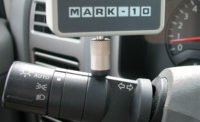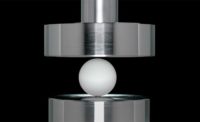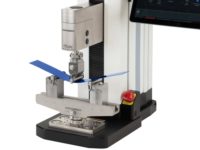Why test compression force?
Compression force testing refers to the measurement of push forces acting upon an object. It is a useful method in quantifying the function or failure of materials, components, assemblies, and finished products. The results of compression tests help to differentiate between an acceptable product and a reject.
Think about a typical daily routine: snapping shut the lid of a shampoo bottle, pressing a wall light switch, turning on a cellular phone. Countless times throughout the day, we’ve produced compression forces to achieve an outcome that makes our routine possible. Besides these more obvious examples of our daily grind, many of the machines we take for granted work well because of behind-the-scenes testing of their internal materials and components.
How is compression force measured?
Compression force can be measured with a force gage or load cell. Common units of measurement in the U.S. include pounds-force (lbF) and Newtons (N), while Newtons and kilograms-force (kgF) dominate in most of the rest of the world.
Force gages and load cells are often used in conjunction with test stands. In a typical configuration, a motorized screw-driven crosshead moves downwards to produce a compression force. A test stand’s electronics can regulate the rate of speed, and stop the motor when a specified load, distance, or sample break has occurred. They are available in self-contained and PC- or tablet-driven models.
Compression force test procedures can be established to conform to ISO, ASTM, or other international standards, or the procedure may be developed in-house to achieve other goals. Whatever the source of the procedure, the following parameters should be taken into account when configuring a system:
- Maximum force anticipated
- Sample shape and size
- Required linear speed
- Requirement for compression force measurement only, or force vs. deflection (travel)
- Interpretation and storage of results
Common Industry Examples:
1. Packaging: Top load testing
That trusty five-gallon water bottle on the office cooler had a long and bumpy journey. At the bottling location, bottles are loaded onto stacking racks, and loaded onto a truck. The stacking racks help to stabilize the bottles as the truck encounters bumps in the road.
Bottles must be durable enough to withstand compressive forces generated by downward motions of the truck. If the bottles were to buckle, crack, or experience other damage, spillage could occur. At bottle manufacturing plants, a top load test can be performed. In this test, a bottle is loaded into a compression testing machine and a compression plate presses down on the neck of the bottle. Depending on the procedure, the machine can produce a target force and then stop, or produce an increasing force until the sample buckles. A minimum force is usually specified, and compared against the test result to determine pass or fail.
2. Plastics: Bend testing
The ongoing plastics revolution has improved the quality of life in areas as broad as medical devices, beverage packaging, construction materials, automotive components, and many others. With continuing innovation in materials engineering, proper testing is critical in qualifying a material before it can be used in a specific product design.
Among the many force tests common in the plastics industry, bend or flexural testing of a plastic strip can yield a wealth of information about the material’s performance. In this test, a sample is supported on two anvils of defined radii. The force is applied either centrally between the two lower anvils for a three-point configuration, or at defined positions on either side of the force axis, for a four-point configuration. The support beams are graduated in inches or millimeters to aid in proper anvil placement.
3. Electronics: Switch contact activation
As this article is being typed, the author is giving little thought to the amount of downward keystroke force to cause characters to appear on the screen. This is the result of careful research and testing by the keyboard manufacturer. The right balance of force and tactile feedback must be accomplished in order to achieve customer satisfaction.
Measuring the force to press down a key is simple, and can even be done with a handheld force gage, however, a specialized force tester function called external trigger can capture the force at which an electrical contact has occurred. Even if the force tester’s probe continued to press into the key, bottoming out and causing an erroneous spike in force, the activation force will have already been correctly captured. This same type of test can be applied to everything from keyboards to cellular telephones to light switches.
4. Medical: Syringe activation
Doctors and nurses use syringes every day. Among the many things they think about for patient care, the amount of force to actuate a syringe plunger should not be one of them. A syringe’s plunger head is designed to fit precisely into the barrel, and produce a consistent resistance as the user presses down on the finger flange.
Compression force can be measured by orienting the sample vertically in a test fixture. A compression plate engages the thumb rest and presses down at a controlled rate of speed. The resulting peak force, average force, or force-travel curve is analyzed to ensure that the syringe does not leak and operates as designed.
5. Springs – Compression spring testing
Used in an unlimited number of applications, from pens to cars, springs help ensure proper operation, longevity, and comfort. For compression spring manufacturers, it is essential to verify the characteristics of the spring. Machine designers must be able to rely on the specifications before they can integrate a spring into their design.
Of common interest is the spring rate, which is defined as the amount of force per unit of deflection. To measure the rate, a compression plate touches the top of the spring, while the position indicator is zeroed. A test procedure will typically call for the spring to be compressed to one or more heights, and the corresponding force readings are measured. These results are compared against the limits established by the designer. When the consequences can be life and death, such as in aerospace and medical applications, proper testing makes all the difference in the world.
Interpreting the data
Compression force data can yield a wealth of information important for quality control professionals. In most applications, the value of most interest is the peak (maximum) force. Companies often compare this value against an acceptable limit range or minimum acceptable value for pass/fail determination.
In other applications, quality professionals must dig deeper than just the peak force. Some compression force testers can output a continuous stream of real time force data that can be displayed in software for further analysis. Graphical force data can help visualize sample behavior. From the slope and profile of a curve, a number of industry-specific calculations can be performed.
In addition to simply plotting data for a single test sample, software can accumulate results from several tests and calculate statistics for a batch or lot. Data can be formatted into report templates typically supplied in force measurement software packages, or exported for further analysis in third party applications.
In summary
More than ever, today’s manufacturers juggle many considerations in their production and quality control activities—from ensuring customer safety and satisfaction to compliance with industry standards to preservation of their reputation. Compression force testing can be a valuable tool in helping achieve quality objectives.








